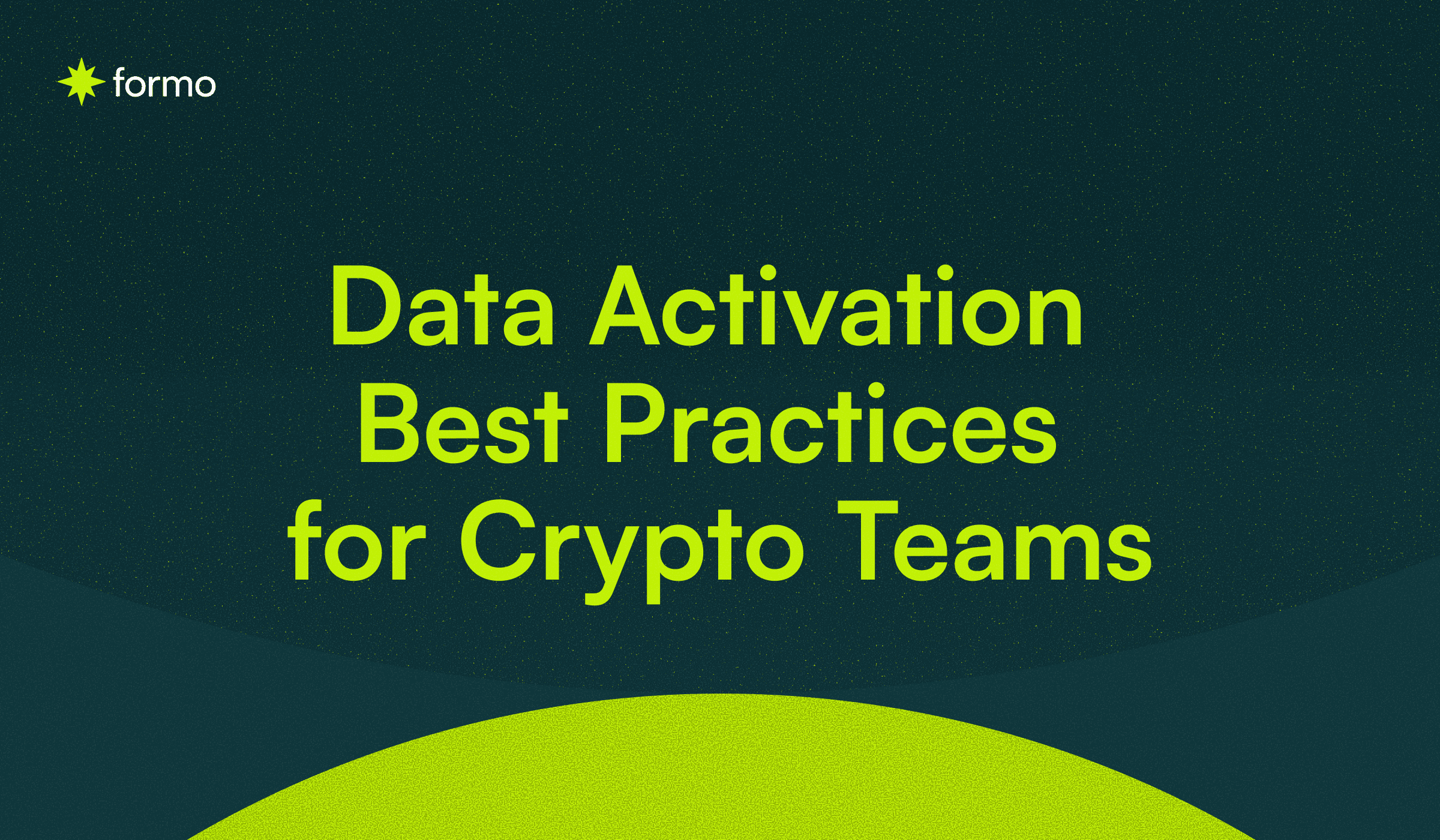Web3 users interact through wallets, own their data, and operate across decentralized ecosystems—challenging traditional approaches to audience analysis and engagement. To succeed in Web3, marketers, developers, and community builders must rethink how they identify and activate users. Whether you're launching an NFT project, building a dApp, or growing a decentralized community, it all begins with understanding your audience. This guide explores the essential strategies, tools, and frameworks to help you effectively engage and grow your Web3 user base.

Web3 audience insights help optimize your product, marketing, and community strategies.
Key Takeaways:
Wallet addresses are the core identity of Web3 users, requiring new approaches to segmentation and engagement.
Web3 user profiles are shaped by onchain behavior, token ownership, and offchain social signals.
Wallet intelligence powers personalization, marketing, product development, and community growth.
Effective segmentation includes behavioral, balance-based, social, and engagement-based groupings.
Tools like Formo, Balloon, Addressable, and MetaCRM help analyze and activate Web3 audiences.
What Is a Web3 Audience?
A Web3 audience consists of users who actively engage with decentralized technologies like blockchains, cryptocurrencies, NFTs, DeFi protocols, DAOs, and dApps. Unlike traditional users identified by emails or usernames, Web3 users are represented by wallet addresses.
These wallets are often pseudonymous, yet publicly trackable—revealing behavior, interactions, and ownership. One wallet could belong to an NFT collector, a DAO contributor, or a DeFi whale. This complexity creates both challenges and opportunities for audience engagement.
Key Characteristics of Web3 Audiences
Understanding these traits is essential to delivering the right product experiences and messaging.
Pseudonymous identity: Users operate via wallet addresses, ENS domains, or decentralized identifiers (DIDs).
Transparent onchain behavior: Activities like trading, staking, minting, or voting are publicly visible.
Cross-platform activity: Users are active on X (Twitter), Farcaster, Discord, Telegram, and Lens.
Token and NFT ownership: Wallets reflect preferences, community affiliations, and interests.
Proof-of-personhood: Tools like World ID and Gitcoin Passport help verify human participants in a privacy-friendly way.
These elements combine into rich, web3 user profiles that still maintain user anonymity, requiring new methods to analyze and engage.
Why Understanding Your Web3 Audience Matters
Gaining insight into your audience is the foundation for building better products, faster growth, and engaged communities. Here are six core benefits of wallet-based audience intelligence:
1. Personalization
Use wallet activity, labels, and token holdings to tailor user onboarding flows and product messaging. Deliver experiences aligned with user interests based on their real wallet activity.
2. Targeted Marketing
Leverage user segmentation to identify whales, loyal users, or newcomers — then run personalized ads, token-gated campaigns, loyalty rewards, or wallet messages that drive engagement and ROI.
3. Community Building
Communities grow stronger when you understand what your members care about. With audience insights, you can design DAO proposals, events, and engagement strategies that resonate, and align incentives with specific user groups such as collectors or DeFi users.
4. Product Development
Understanding your audience helps you identify which features resonate with power users, which flows create drop-offs, and what’s missing from the experience. Wallet intelligence ensures that product roadmaps reflect actual user needs, reduces the risk of misalignment, and accelerates product–market fits.
5. Monetization
Audience insights help you identify users most likely to convert or upgrade. Offer premium tiers, tokens, or experiences based on wallet behavior and spending history to boost monetization.
6. Performance Measurement
Go beyond surface metrics by tracking engagement, retention, and conversion across wallet cohorts. Web3 audience insights give you insights on what’s working and where to improve.
How to Analyze and Understand Your Web3 Audience
1. Conduct Market Research
Traditional methods like surveys, interviews, and focus groups still apply. Combine qualitative insights with onchain behavior to understand motivations and preferences.
2. Leverage Web3 and Product Analytics
Track user actions across your dApp or site—page views, drop-offs, and feature clicks. Blend this with onchain data to map the full user journey and uncover what drives engagement or churn.

Connect onchain product usage with visitor metrics to uncover growth drivers and drop-off points.
3. Listen on Social Channels
Monitor platforms like X, Farcaster, Discord, and Reddit for real-time feedback, sentiment, and trends. Social listening captures context that dashboards can’t.. Monitor what excites or frustrates users, and stay updated on trends.
4. Build Web3 Audience Personas
Segment users by experience, goals, and behaviors. Web3 user personas help tailor product messaging, content, and UX to specific wallet segments and behaviours.
5. Analyze Competitors
Study leading projects in your space. See how they handle messaging, segment users, and engage communities—then refine your own strategy.
How to Segment Your Web3 Audience
Web3 user segmentation allows you to categorize wallet owners based on shared traits or behaviors. Here are four effective segmentation strategies:
1. Behavioral Segmentation
Segment users based on how they behave onchain. What apps do they use? Are they active traders or long-term holders? Do they participate in governance or simply observe? Do they transact frequently or infrequently? These behavioral patterns reveal intent and help you tailor experiences based on usage style and depth of involvement.
2. Wallet Holdings Segmentation

Identify, understand, and engage your users to drive sustainable Web3 growth.
Segment users by the type and value of assets they own—whales with large portfolios, NFT collectors with diverse collections, or token-specific holders like ETH maxis or UNI stakes. Segmentation helps you craft targeted campaigns or perks tied to token ownership.
Relevant wallet insights:
Top dapps
Top tokens
Top chains
A breakdown of users by net worth
A breakdown of users by revenue/wallet spend
Wallet labels
3. Social Segmentation
Connect wallets to social activity on X, Lens, Farcaster, or Discord to understand your users’ interests and engagement offchain. Identify influencers, creators, and community members to build socially aware campaigns that convert.
4. Engagement Segmentation
Segment users by engagement level:
- recently active vs. dormant,
- visited but never transacted, or
- received airdrops but never used the product.
These insights help re-engage users with relevant nudges or incentives before they leave for good.
Building Web3 Audience Personas
Personas are as powerful in Web3 as they are in Web2—just more data-rich. Here's how to build them:
Wallet age: How long your members have been active on-chain
Wallet activity: Identify power users vs dormant holders
Wallet value: Total, average, and median net worth
Net worth distribution: Identify whales and mid-tier users
Cross-chain data: Assets held across multiple chains
Token breakdown: Tokens your audience holds
Wallet labels: Filter by user behaviour and onchain history
ENS profiles: Wallet identities are often connected to social profiles
XMTP availability: Know who you can reach via onchain messaging
Demographics: Countries and desktop vs. mobile
Social activity: Engagement on X, Lens, Farcaster
Social reach: Your community’s social footprint
Social followers: Uncover micro-influencers and major voices
Example Persona: NFT Collector
Wallet Age: 18 months
ENS Domain: Yes
Average NFT Spend: $3,000
Activity Level: High
Platforms: X, Lens
Behavior: Explorer, early adopter, collector
Use multiple personas to align marketing, product features, and community engagement with real user profiles.
Top Tools for Web3 Audience Intelligence
A new generation of platforms makes wallet segmentation and user analysis more accessible and scalable.
1. Formo

Explore Formo: A Web3-native wallet intelligence platform for growth teams.
Formo is a Web3-native wallet intelligence platform built for product and marketing teams. Formo enables you to:
Build wallet profiles and segment top users based on onchain activity, token holdings, and off-chain engagement.
Send wallet messages to your target audience for more effective acquisition and engagement.
Track performance across the user lifecycle with features such as funnels, retention cohorts, UTM tracking, and more.
Capture onchain insights through token-gated forms and surveys that unlock richer user feedback.
2. Addressable

Explore Addressable: Connect wallet data to offchain ads and retargeting campaigns.
Addressable connects onchain and offchain user data for targeted marketing:
Run wallet ads across Twitter and 400,000+ websites
Access over 500 predefined audience segments
Retarget users based on onchain traits and labels
3. MetaCRM

Discover MetaCRM: A Web3-native CRM for personalized, wallet-based user engagement.
A Web3-native CRM for holistic user engagement.
Sync wallet activity with social profiles and user history
Personalize communication across marketing, sales, and support
Manage community interactions and wallet data in one place
Summary
Web3 audience intelligence goes beyond basic demographics. It involves analyzing wallet activity, token ownership, and social presence to create meaningful, personalized experiences.
By segmenting users and leveraging advanced analytics tools, teams can drive personalization, community engagement, and product growth. As the Web3 ecosystem matures, wallet intelligence will be a key competitive edge for product builders and marketers onchain.
Additional reading:
Follow Formo on LinkedIn and Twitter, and join our community to learn how you can turbocharge growth onchain!
FAQs
1. What makes a Web3 audience different from a Web2 audience?
In Web3, users are identified by wallet addresses instead of emails or usernames. Their activity—including transactions, token ownership, and dApp interactions—is recorded onchain, creating public yet pseudonymous profiles. This transparency enables data-rich insights but requires new methods for segmentation and engagement.
2. How do I segment a Web3 audience effectively?
Effective segmentation in Web3 involves grouping users by:
Onchain behavior (e.g., trading, staking, minting)
Token and NFT ownership (e.g., whales, collectors, airdrop farmers)
Social presence (e.g., active on X, Farcaster, Discord)
Wallet metadata (e.g., wallet age, ENS domain, XMTP availability)
These criteria help you personalize messaging, design smarter campaigns, and prioritize high-value users.
3. What tools can I use to analyze and understand Web3 users?
Several platforms specialize in Web3 audience intelligence:
Formo – Wallet profiling, segmentation, lifecycle analytics, and wallet messaging
Addressable – Connects wallets to offchain ads, enabling retargeting and campaign personalization
MetaCRM – A Web3-native CRM that integrates wallet data with marketing and customer support workflows
These tools help teams turn wallet data into actionable insights across marketing, product, and community strategies.
4. Why is wallet intelligence important in Web3?
Because most Web3 users operate under pseudonymous identities, traditional user data is limited or absent. Wallet intelligence bridges this gap by uncovering user behavior, value, and intent directly from the blockchain. This enables:
Personalized user experiences
Smarter segmentation and targeting
Stronger community engagement
More effective growth and retention strategies
5. Can I still use traditional research methods in Web3? Yes—surveys, interviews, and focus groups remain valuable for gathering qualitative insights. When combined with onchain data, these methods give you a complete view of user motivations, preferences, and behaviors, enhancing both strategy and execution.





